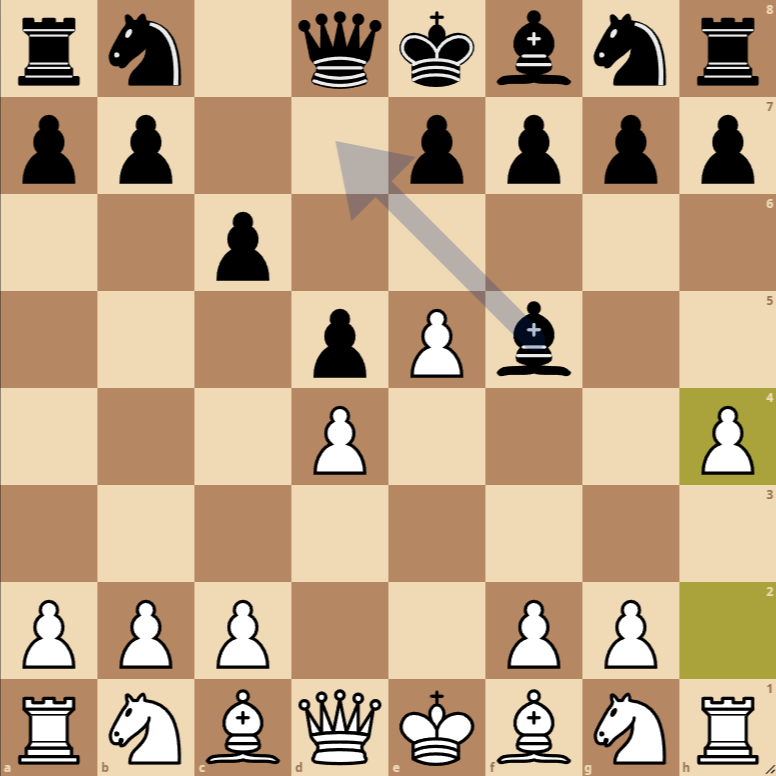How to Play the Caro-Kann Defense Opening, Advanced Variation, Tal Variation
- 1. e4: White starts with the king’s pawn moving two squares forward, aiming to control the center and open paths for their bishop and queen.
- c6: Black responds by preparing d5 to counterattack in the center. This move marks the beginning of the Caro-Kann Defense, which aims for a solid and structured game.
- 2. d4: White continues their development by occupying the center and preparing the deployment of minor pieces.
- d5: Black carries out their plan, advancing the pawn to d5 to challenge White’s central dominance.
- 3. e5: White advances the pawn to e5, entering the Advanced Variation of the Caro-Kann Defense. This move seeks to gain space and limit Black’s options.
- Bf5: Black develops their bishop to f5, a typical move in this defense, aiming for rapid development and maintaining tension in the center.
- 4. h4: White plays h4, signaling the start of the Tal Variation, with the intention of displacing the black bishop from f5 and potentially launching an attack on the kingside.
Variations of the Caro-Kann Defense Opening, Advanced Variation, Tal Variation
h5 Variation
A common response for Black after 4.h4 is to play h5, aiming to prevent g4 and keep the bishop on f5. This leads to complex pawn structures and tense play on the kingside.
Aggressive g4 Variation
After 4…Bf5, White can choose to play g4, directly challenging the bishop on f5. This aggressive line aims to open lines on the kingside at the cost of weakening their own pawn structure.
Nh6 Knight Maneuver
In some variations, Black may develop the knight to Nh6, intending to bring it to f5 to exert pressure on d4 and respond to White’s pawn advances on the kingside.
Advanced Variation of the Caro-Kann Defense
The Caro-Kann Defense, Advanced Variation, Tal Variation, is an opening rich in strategies and tactics for both sides. After the moves 1.e4 c6 2.d4 d5 3.e5 Af5 4.h4, the position is characterized by the struggle for control of the center and preparation for the development of minor pieces. White has advanced their pawn to e5 to gain space in the center and limit Black’s options, while Black responds by developing the bishop to f5, seeking to pressure the e4 pawn and counter the White center.
Strategies for White:
- Kingside Expansion: With 4.h4, White aims to disrupt the bishop on f5. The idea can continue with g4 to gain space and, if possible, trap the black bishop. This can lead to an early kingside attack if Black does not respond correctly.
- Center Control and Attack Preparation: Maintaining the pawn on e5 is crucial for White as it provides strong control of the center and prepares the ground for future attacks on the kingside or in the center.
- Development and Castling: White should quickly develop their minor pieces and castle, preferably on the kingside, to ensure the safety of the king and continue with an attacking plan.
Strategies for Black:
- Counterattack in the Center: Faced with White’s advance, Black can aim to counter in the center with moves like d4, trying to challenge White’s central pawn structure and open lines for their pieces.
- Kingside Play: With White’s h4 move, Black has several options. Moves like h5, h6, or e6 offer different plans:
- h5: Aims to stop White’s g4 advance and keep the bishop on f5. This move focuses on holding the position and preparing for actions in the center or on the queenside.
- h6: Prepares the bishop’s retreat to h7, avoiding capture after g4. This move is more defensive and seeks a reorganization of Black’s pieces to counter the White center.
- e6: Aims to solidify the center and prepare the development of the dark-squared bishop, possibly to e7. This move also opens the possibility of kingside castling and maintaining a balanced game.
Common Tactics:
- Pawn Sacrifice: White may consider sacrificing the pawn on h5 (if Black plays h5) to open the h-file and activate their rook. This type of sacrifice aims to destabilize the Black king and create attacking opportunities.
- Counterattack in the Center:

